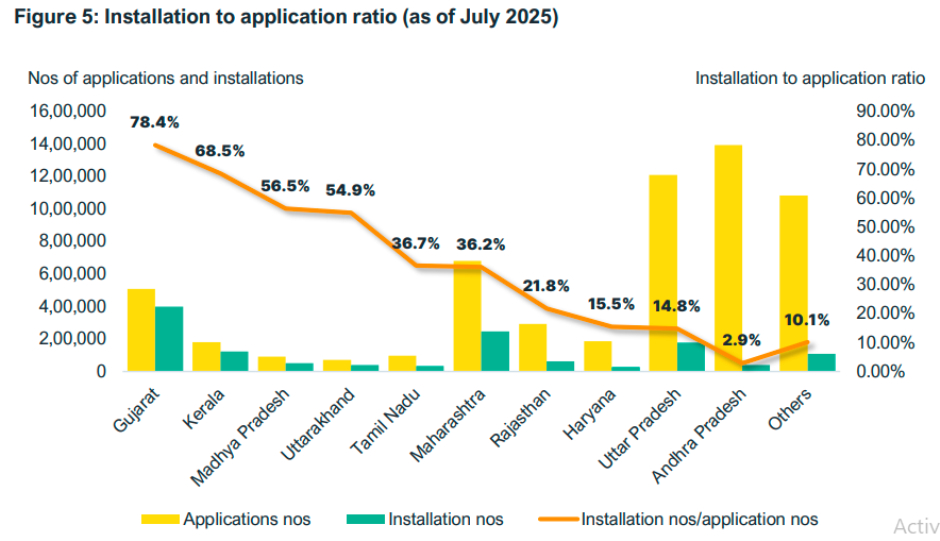India’s residential rooftop solar (RTS) segment is witnessing an unprecedented surge under the Pradhan Mantri Surya Ghar: Muft Bijli Yojana (PMSGY), according to Institute for Energy Economics and Financial Analysis.
As of July 2025, the scheme has spurred remarkable growth in applications and installations, driven by strong policy incentives, public awareness, and technological innovation. However, challenges remain in achieving the ambitious 1 crore rooftop target by FY2027, according to JMK Research.
Here are 10 key points highlighting the state of India’s rooftop solar market in 2025.
1. Record Surge in Applications and Installations
As of July 2025, over 57.9 lakh applications were submitted for residential rooftop solar installations, resulting in 4,946 MW of installed capacity across India. This reflects a robust on-ground rollout and growing public trust in the PMSGY initiative.
2. Substantial Subsidy Disbursements
The scheme has disbursed INR 9,281 crore (USD 1.05 billion) in subsidies, benefiting over 16 lakh households. The financial support has accelerated adoption among middle-income and semi-urban households, reinforcing the affordability of solar energy.
3. Gujarat Leads India’s Rooftop Solar Race
Gujarat remains the national frontrunner with 1,491 MW of installed residential rooftop solar capacity. Maharashtra, Uttar Pradesh, Kerala, and Rajasthan follow, collectively accounting for 77.2 percent of total installations under PMSGY.
4. Goa Tops in System Size
While Gujarat dominates in total capacity, Goa leads in system efficiency, with an average rooftop solar system size of 8.7 kW — more than double the national average of 3.82 kW. Delhi and Punjab also stand out with higher system capacities, driven by urban energy demand and favorable incentives.
5. Conversion Ratio Highlights Implementation Gaps
The installation-to-application conversion ratio at the national level stands at 22.7 percent, showing that execution challenges persist. However, states like Gujarat, Kerala, and Madhya Pradesh, and Union territories such as Ladakh, Puducherry, and Lakshadweep, have crossed the 50 percent mark, indicating higher efficiency.
6. Uneven State Performance
While Gujarat and Kerala boast conversion rates above 65 percent, Uttar Pradesh (14.8 percent) and Andhra Pradesh (2.9 percent) lag due to vendor shortages and procedural delays. This disparity underscores the need for localized strategies and better vendor management systems.
7. Workforce Development Boosts Execution
The capacity-building program under PMSGY aims to train over 3 lakh individuals by 2027, including 1 lakh solar PV technicians. By August 2025, more than 51,000 professionals had already been certified, strengthening the rooftop solar ecosystem across states.
8. Innovation Driving Future Growth
The Innovative Projects Component launched in June 2025 promotes R&D and start-up participation. MNRE offers up to 60 percent funding support (max INR 30 crore) for pilot projects, encouraging new solar technologies and business models for households and utilities.
9. State-Level Subsidies Accelerate Adoption
Several states, including Goa, Delhi, Assam, Uttar Pradesh, and Uttarakhand, have introduced additional capital subsidies (up to 80 percent of system cost) and SGST reimbursements to reduce upfront costs. These incentives have further shortened payback periods and boosted adoption.
10. Shorter Payback Period Strengthens Consumer Appeal
The payback period for a 3 kW rooftop solar system has dropped to 30 months with subsidies, compared to 54 months without. This faster return on investment, coupled with rising electricity prices, is driving more households to embrace solar power.
Conclusion
India’s rooftop solar market is on a strong upward trajectory under the PM Surya Ghar Muft Bijli Yojana, combining robust central support, state-level incentives, and technological innovation. However, to meet the 1 crore rooftop target by FY2027, India must address regional disparities, vendor shortages, and streamline implementation to convert demand into installations efficiently.
Baburajan Kizhakedath

